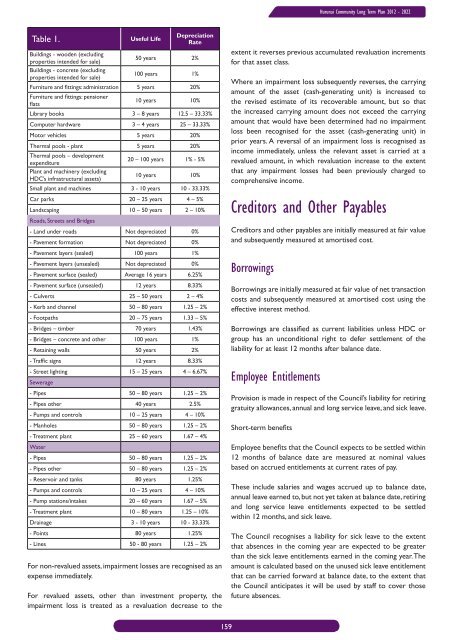Long Term Community Plan 2012-2022 - Hurunui District Council
Long Term Community Plan 2012-2022 - Hurunui District Council
Long Term Community Plan 2012-2022 - Hurunui District Council
You also want an ePaper? Increase the reach of your titles
YUMPU automatically turns print PDFs into web optimized ePapers that Google loves.
<strong>Hurunui</strong> <strong>Community</strong> <strong>Long</strong> <strong>Term</strong> <strong>Plan</strong> <strong>2012</strong> - <strong>2022</strong><br />
Table 1.<br />
Useful Life<br />
Depreciation<br />
Rate<br />
Buildings - wooden (excluding<br />
properties intended for sale)<br />
50 years 2%<br />
Buildings - concrete (excluding<br />
properties intended for sale)<br />
100 years 1%<br />
Furniture and fittings: administration 5 years 20%<br />
Furniture and fittings: pensioner<br />
flats<br />
10 years 10%<br />
Library books 3 – 8 years 12.5 – 33.33%<br />
Computer hardware 3 – 4 years 25 – 33.33%<br />
Motor vehicles 5 years 20%<br />
Thermal pools - plant 5 years 20%<br />
Thermal pools – development<br />
expenditure<br />
20 – 100 years 1% - 5%<br />
<strong>Plan</strong>t and machinery (excluding<br />
HDC’s infrastructural assets)<br />
10 years 10%<br />
Small plant and machines 3 - 10 years 10 - 33.33%<br />
Car parks 20 – 25 years 4 – 5%<br />
Landscaping 10 – 50 years 2 – 10%<br />
Roads, Streets and Bridges<br />
- Land under roads Not depreciated 0%<br />
- Pavement formation Not depreciated 0%<br />
- Pavement layers (sealed) 100 years 1%<br />
- Pavement layers (unsealed) Not depreciated 0%<br />
- Pavement surface (sealed) Average 16 years 6.25%<br />
- Pavement surface (unsealed) 12 years 8.33%<br />
- Culverts 25 – 50 years 2 – 4%<br />
- Kerb and channel 50 – 80 years 1.25 – 2%<br />
- Footpaths 20 – 75 years 1.33 – 5%<br />
- Bridges – timber 70 years 1.43%<br />
- Bridges – concrete and other 100 years 1%<br />
- Retaining walls 50 years 2%<br />
- Traffic signs 12 years 8.33%<br />
- Street lighting 15 – 25 years 4 – 6.67%<br />
Sewerage<br />
- Pipes 50 – 80 years 1.25 – 2%<br />
- Pipes other 40 years 2.5%<br />
- Pumps and controls 10 – 25 years 4 – 10%<br />
- Manholes 50 – 80 years 1.25 – 2%<br />
- Treatment plant 25 – 60 years 1.67 – 4%<br />
Water<br />
- Pipes 50 – 80 years 1.25 – 2%<br />
- Pipes other 50 – 80 years 1.25 – 2%<br />
- Reservoir and tanks 80 years 1.25%<br />
- Pumps and controls 10 – 25 years 4 – 10%<br />
- Pump stations/intakes 20 – 60 years 1.67 – 5%<br />
- Treatment plant 10 – 80 years 1.25 – 10%<br />
Drainage 3 - 10 years 10 - 33.33%<br />
- Points 80 years 1.25%<br />
- Lines 50 - 80 years 1.25 – 2%<br />
For non-revalued assets, impairment losses are recognised as an<br />
expense immediately.<br />
For revalued assets, other than investment property, the<br />
impairment loss is treated as a revaluation decrease to the<br />
extent it reverses previous accumulated revaluation increments<br />
for that asset class.<br />
Where an impairment loss subsequently reverses, the carrying<br />
amount of the asset (cash-generating unit) is increased to<br />
the revised estimate of its recoverable amount, but so that<br />
the increased carrying amount does not exceed the carrying<br />
amount that would have been determined had no impairment<br />
loss been recognised for the asset (cash-generating unit) in<br />
prior years. A reversal of an impairment loss is recognised as<br />
income immediately, unless the relevant asset is carried at a<br />
revalued amount, in which revaluation increase to the extent<br />
that any impairment losses had been previously charged to<br />
comprehensive income.<br />
Creditors and Other Payables<br />
Creditors and other payables are initially measured at fair value<br />
and subsequently measured at amortised cost.<br />
Borrowings<br />
Borrowings are initially measured at fair value of net transaction<br />
costs and subsequently measured at amortised cost using the<br />
effective interest method.<br />
Borrowings are classified as current liabilities unless HDC or<br />
group has an unconditional right to defer settlement of the<br />
liability for at least 12 months after balance date.<br />
Employee Entitlements<br />
Provision is made in respect of the <strong>Council</strong>’s liability for retiring<br />
gratuity allowances, annual and long service leave, and sick leave.<br />
Short-term benefits<br />
Employee benefits that the <strong>Council</strong> expects to be settled within<br />
12 months of balance date are measured at nominal values<br />
based on accrued entitlements at current rates of pay.<br />
These include salaries and wages accrued up to balance date,<br />
annual leave earned to, but not yet taken at balance date, retiring<br />
and long service leave entitlements expected to be settled<br />
within 12 months, and sick leave.<br />
The <strong>Council</strong> recognises a liability for sick leave to the extent<br />
that absences in the coming year are expected to be greater<br />
than the sick leave entitlements earned in the coming year. The<br />
amount is calculated based on the unused sick leave entitlement<br />
that can be carried forward at balance date, to the extent that<br />
the <strong>Council</strong> anticipates it will be used by staff to cover those<br />
future absences.<br />
159

















